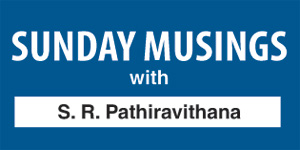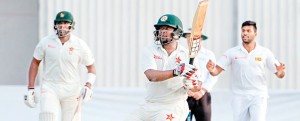Cricket’s emigration culture and the new kids on the block
View(s):When I saw the new Lankan fast bowler Lahiru Kumara operating during the first Test against Zimbabwe I was impressed. In Lahiru, we have discovered a young cricketer who has most of the ingredients that a true fast bowler should possess. Now that he is on the stage it is up to Ford and company to see that he is made to perform.
Kumara possesses the ideal build for a fast bowler – I mean talking of international standards. He has the right physique and quite a fluid action and he hits the deck hard. At the same time the speed tracker more than once clocked him at over 140kmh. Yet he should not be so foolish as to tire himself by keeping on to his optimum, all the time. It is suggested that he maintain his current speed between 128 and 135kmh and use the faster delivery as his weapon. He did just that successfully during that game. At nineteen plus he has a whole life ahead of him to develop.

Lahiru Kumara, Sri Lanka's new find
For a moment, I am not saying that Sri Lanka has found the magic potion for all ills in that section of the game, but, what I propose is that he is the right ingredient that we should foster and find ways to see that he stays injury-free while developing his speed and control.
Delving into his history, I found out that at the under seventeen stage, Kumara was trying his skills at Sri Sumangala, Kandy until the then Trinity College coach Sampath Perera coaxed his school to adopt the fledgling fast bowler.
This meant that Kumara came under a top notch coach who knew his onions and in no time, Kumara’s stock increased. Within a few years, the youngster is representing his country in a Test match. I wonder if Kumara had stayed on at Sri Sumangala he would have graduated in the same manner.
I say this because at Trinity, Kumara came under a good coach. The school had all the facilities — and he was exposed to good quality cricket that the school plays during the season.
This is the base point of my argument. Now every Pala and Dasa wants to be a part of cricket and there are more and more schools which are taking to the game, but, the question is could they sustain the momentum? They take part in the same tournament that the others do, but, could the lesser schools provide the same exposure and facilities to take school cricket as a whole to the next echelon.
 I have seen some cricketers who fail to make the grade after playing their primary cricket at secondary schools. These schools cannot provide the top quality facilities that I mentioned before and they fall by the way side either through injury or failing to adopt. That is the majority, but, there have been some cricketers like Sanath Jayasuriya who has even turned the concept of cricket up side down, in spite of his small beginnings.
I have seen some cricketers who fail to make the grade after playing their primary cricket at secondary schools. These schools cannot provide the top quality facilities that I mentioned before and they fall by the way side either through injury or failing to adopt. That is the majority, but, there have been some cricketers like Sanath Jayasuriya who has even turned the concept of cricket up side down, in spite of his small beginnings.
Migration of cricketers started eons ago, but, at that time it occurred in an ad hoc manner. For instance, when a public servant was transferred the whole family used to shift and invariably the children of those public servants also moved to new schools. Besides, even forty years ago there were cricketers like Ajith de Silva who moved from Dharmasoka Ambalangoda to Ananda Collage or Dulip Mendis who walked across the street to move from St. Sebastian’s to S. Thomas’. But, it did not come all and sundry – there was no set pattern.
But, gradually the scenario began to change. Even the established schools began to change their attitude and they also changed from having their old boys coaching the school to employing fully fledged coaches who were contracted to produce results. In the good old days, at Ananda College, coach Anuruddha Polonnowita used to drive his Ford Prefect after work. He would casually inspect the cricketers at practice and give them advice or rebuke them if needed and the wagon strode on.
But, now it is an industry. There is the coach, the physio, the batting coach and more and the cricketers keep fit by working at the gym. At the same time the business of representing one’s school in cricket especially in a branded institution like Royal, Ananda, S. Thomas’ or Trinity is not easy.
The coach is an alien species who has no moral obligation to the school and so does the school. He only has to keep producing positive results so that the school’s stocks stay high in the eyes of its OBA. The unwritten moral that the coach has is – the coach has the permission to fish out talent so that school gets good results at the end of the season. Negative results means – the coach would have to find another stove to bake his bread.
This means, the coach is on the move 365/12 looking for life sustaining results. This situation has culminated in this culture of cricket emigration.
Just look at the present national team which is on tour. Kaushal Silva migrated from Sri Sumangala, Panadura to S. Thomas’. Dimuth Karunaratne moved from Asoka Junior to St. Joseph’s. Kusal Janith Perera first played for Dharmapala Kottawa before he joined Royal. Suranga Lakmal was an original product of Debarawewa MV, Hambantota before he moved to Richmond.
Anandian Dinesh Chandimal represented Dharmasoka Ambalangoda at junior level while Richmond’s Dhananjaya de Silva had his primary education at Debarawewa. Left arm chinaman bowler Lakshan Sandakan was a student at Karunaratne Buddhist MV, Mattumagala before crossing over to de Mazenod College, Kandana, while Kumara played for Sri Sumangala, Kandy.
 This means the even unintentionally the emigration culture that the schools have adopted has helped the national cause a great deal. In the list there are more national cricketers who have graduated from other schools, but, we will stop at that for now. However, when you take the entire schools’ arena the numbers are huge. Last season, a school just outside Colombo had two budding cricketers and they offered to be shifted. One was to their senior brother school, but, they had the numbers. So the other brother school took one while the other moved to the school next to Royal. Now both are number three batters for their respective institutions.
This means the even unintentionally the emigration culture that the schools have adopted has helped the national cause a great deal. In the list there are more national cricketers who have graduated from other schools, but, we will stop at that for now. However, when you take the entire schools’ arena the numbers are huge. Last season, a school just outside Colombo had two budding cricketers and they offered to be shifted. One was to their senior brother school, but, they had the numbers. So the other brother school took one while the other moved to the school next to Royal. Now both are number three batters for their respective institutions.
Then there is this down side also. I remember some time ago, a high up at Sri Lanka Cricket was complaining. He was a former national team opening batsman himself. He was complaining about the cricketers being taken to the schools by the sea in numbers and this culminates in the home grown being left out, because the incumbent coach makes sure that he gets the best imported stuff to his larder.


